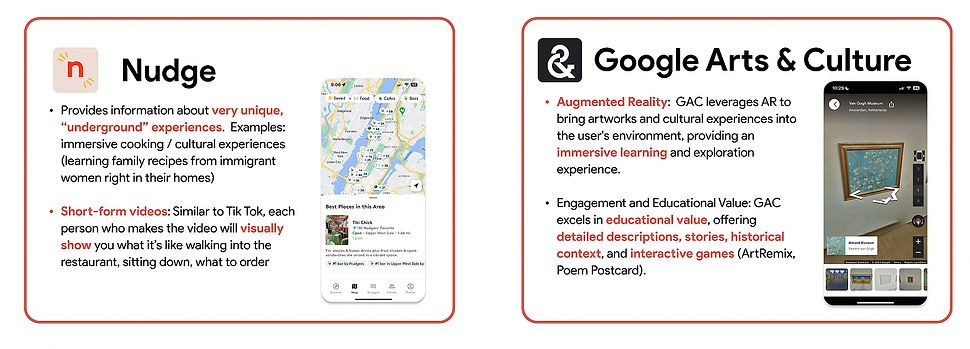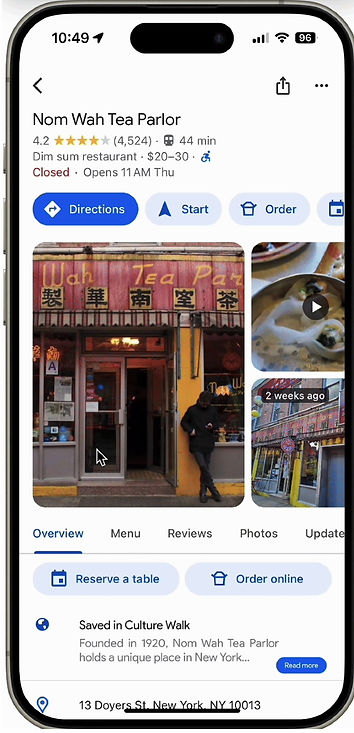00. Background
Urban places are faced with an evolving identity struggle in today's digital age. Geolocative* social media, especially Instagram and Facebook, commercialize local culture in cities like New York. Social media's influence can construct a superficial, immaterial representation of a neighborhood, erasing the complex communities that exist in the actual physical space.
*"Geolocative" is defined as media that locates the user in physical space, most often using Global Positioning System (GPS) technology embedded in smartphones. These platforms provide rich and monetizable data about where users are in space and time and help actively construct and represent material places in immaterial space by users and their audiences in real-time, regardless of their physical location. Walters, P., & Smith, N. (2024). It’s So Ridiculously Soulless: Geolocative Media, Place And Third Wave Gentrification. Space and Culture, 27(1), 94-109. https://doi.org/10.1177/12063312221090428
Role
Qualitative research, ideation, user testing, prototyping
Time
8 weeks, Feb. - Mar. 2024
Design team
Caroline Zhang (Teachers College ‘25)
Hongqian Li (GSAPP ‘24)
Christine Lam (Barnard ‘26)
01. User Research
To help us narrow down our problem space, we started with user research.
Quantitative
Quantitative research was conducted via a survey through various channels: Columbia undergrad and grad schools* group chats, Instagram, and Reddit, primarily targeting 18-24 year olds.
*Columbia Graduate School of Architecture, Planning and Preservation, Columbia Teacher’s College, Barnard 2025 GroupMe, Columbia 2025 GroupMe, Women in CS GroupMe
Qualitative
Four ethnographic interviews were conducted on the following groups, all aged 18-24 years old.
(1) NYC local (in NYC 10+ years)
(2) Recent transplants (in NYC ~1-3 years)
(3) Future intern in NYC (in NYC ~2 months)
Survey results
Based on our survey results from 49 participants, we determined that:

Interview results
We conducted 4 ethnographic interviews spanning different 18-24 year old user groups. Here's what we found:
1. Locals sometimes refrain from disclosing hidden gems to prevent overcrowding, adopting a “gatekeeping” mentality.
“[Locals] gatekeep [the pizza shop], just like me. If I was to go “snitch” on this place, it's like I started the whole thing. You don't want to be the cause [of] the next tourist area.”
- Brooklyn native of 10+ years
2. When searching for places to visit, tourists and transplants often:
-
Feel overwhelmed by too many choices.
-
Value location proximity and activities that align with their needs and emotional state.
-
Draw inspiration from social media platforms and the internet.
-
Consider visually-appealing locations for social media posts.
“[If] I’m going to my dance class and if I’m having dinner with a friend later, I will look for certain areas that are both close to us. Because I highly value efficiency. Another [scenario] is depending on my mood, I will search for cute cafes to work in. ”
- Student at Teachers College of 2 years
“[The appeal] is 100% visual, especially if the video is filmed in really good lighting…in such a social-media-fueled generation, I want to go to spots where I could take pictures. I can show other people I've been to that spot...to prove to other people that I have a fun life.”
- College student interning in NYC
02. Problem Statement
New Yorkers often lack a deep understanding of the cultural significance of the places they visit, leading to erosion of respect for local cultures and a superficial perception of the city perpetuated by social media.
How can we develop a tool that enriches the experience of New Yorkers by offering historical and cultural insights to foster appreciation and respect for local culture?
03. Competitor analysis
What platforms already exist that seek to address our problem statement?
What can we learn from them -- and what can we improve on?

04. Our idea
New York City is a living, ever-changing museum of history and culture.
Inspired by guided museum and audio tours, we aim to create a new feature for Google Maps that provides users cultural and historical insights about the areas they visit around New York City.
05. Design iterations
During the ideation phase, we brainstormed four features and iterated on them further.
1. Integration into Google Maps system.
How can we enable users to seamlessly transition from the Google Maps route page into Culture Walk?

Overview of iterations

Integration via button
2. Personalize experience by selecting categories of interest
How can we allow users to personalize their Culture Walk experience -- whether that be choosing audio tours or categories of interest - while abiding by existing design patterns?

3. Viewing/listening fact cards
How can we elegantly present fact cards during walking navigation in a non-disruptive manner?

Overview of iterations

Fact card as a bottom sheet
4. Enabling augmented reality with Live View.
How can we supplement Live View's already immersive user experience with Culture Walk fact cards?

Overview of iterations

Modal dialog in Live View
06. User testing
We interviewed three potential users on the aforementioned features and gathered the following insights:
Allow users to digitally revisit past locations
Users wish to remember places they previously explored IRL.
Clarify content design of "Uncover more"
Refine wording of "Uncover more" button to become more intuitive.
Improve readability of fact cards
Fact cards are overloaded with information and difficult to read, especially on-the-go.
07. Hi-fi prototypes

Flow 1.
Culture Walk via walking navigation
Meeting users where they're at by accessing Culture Walk through the classic Google Maps navigation.

Flow 2.
Culture Walk via Live View, using AR
Immersing users directly into the location of interest using augmented reality and pop-up dialogs with historical facts.

Flow 3.
Cultural Archive
A consolidated space for housing users have already visited, serving as digital memorabilia.

Flow 4.
Categories of interest
Enabling users to personalize their Culture Walk experience by setting topics of interest and toggling audio on/off.
08. Feedback from Googlers
We presented our designs to several Google UX Designers at the NYC office and received the following feedback:
"Prioritize audio or larger text [especially in walking mode] -- take inspiration from Spotify karaoke mode."
"Integrate with Google Lens: get a notification like, "Get off bus here! Cool restaurant right around the corner."
"Add a planning feature; if people are going to other cities and traveling, and just meandering around, [help them plan their trip]."
08. Takeaways & acknowledgements

Thank you to my wonderful teammates Caroline, Hongqian, and Christine for making this project a success!
Special shoutout to Design@Columbia for making this opportunity a reality; and for all the Googlers who spent an afternoon listening to our presentations!

We leaned into our unique backgrounds and skillsets to maximize our time together.
Hongqian's architecture background, Caroline's connections to NYC newcomers, Christine's native understanding of Chinatown, and my knowledge of the end-to-end UX process shone through.




